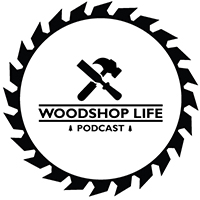Support us on Patreon: https://www.patreon.com/woodshoplife
Sean
1) Hey fellas. So I’m having some trouble getting nice glue lines when I’m edge jointing long boards (6’+). I’m building a table top (72”x36”) out of hard maple. How particular are each of you when building table tops? Should the glue joints be flush off the jointer? Do you massage them with a hand plane? Are small gaps ok as long as they close up with a bit of clamping pressure?
I have checked, rechecked and rerechecked my jointer and it seems dialed in so I’m pretty sure this is user error.
Thoughts on using a magnetic feather board on the infeed side of the jointer to help with stability?
Love the show – keep it coming!
Mark
MLBettWoodWorks
2) Hey guys I have a question/conversation. Just wanted to get your guys thoughts on the topic of the expense of woodworking as a hobby. I feel a lot of woodworking influencers I guess you’d call them are afraid to actually talk about the real cost of woodworking. I feel it’s taboo or something. If your someone who is cheap or doesn’t have the means I don’t think this is the hobby for you. Things like having a climate controlled shop. Having proper dust collection. Having all the proper 220 installed in your shop. Then having the right tools to do each operation. I dunno I guess I’m just blunt about it. If you wanna do this hobby right and also safely it’s a lot of money. Just wondering your thoughts
Nathaniel
Guy
1) Thanks for the best woodworking podcast around! It’s so good to have a podcast that’s all relevant information and without the hosts’ constant snickering among themselves, as if they think that’s entertaining. Here’s a question regarding pocket hole joinery:
When assembling cabinets for my shop, and other projects using pocket screws, I often end up with the parts sliding out of alignment as the screws are installed. I have and use the Kreg clamp that has the pin that goes in one of the pocket screw holes, but still often end up with the parts slightly misaligned. I’m considering driving a couple pin nails before driving the screws. Any other ideas that won’t leave telltale (albeit small) holes that have to be dealt with?
Thanks again for the great format! Tim
2) Hey guys,
I’ve been pondering the idea of adding a second smaller dust collector to my shop instead of upgrading to a 3 hp system fully piped to each machine.
Currently I’m in a small basement shop that’s about 400 square foot. I have a HF dust collector with a cyclone and filter. I’ve piped it with 4” to the table saw, jointer, planer and miter saw. It’s not the best but it gets most of the chips from the planner and struggles with the other machines.
My thought was to add a wall mounted dust collector to the table saw and the miter saw. Then leave the planer and jointer hooked up to the cycle dust collector.
Curious how much of a difference a larger dust collector fully piped would make.
Thanks,
Jesse
Huy
1) Hey Guys…Wondering if you could give us opinion of the Festool domino machine. Any tips and tricks you may have figured out? Can the cutters be resharpened? What size domino do you mainly use? Do you make your own dominoes vs. buying them? Just curious. – Dale
2) Hello gentlemen. First, thanks for your input w/r/t my belt sander question. I did keep it, and it saved me a bunch of elbow grease on an epoxy project.
I’m kicking around the idea of installing a wood floor in my shop which is a 2 car garage with a concrete floor. I would frame it with 2×4 with plywood on top of those right over the concrete. Benefits include :
– easier on my feet
– save the edges of my dropped tools
– be able to run electric & dust collection, among others. I can’t seem to find any drawbacks outside of the cost. What am I missing? For the record no cars park inside, and I do have large stationary tools including a table saw, 6” jointer, bandsaw etc.
weight considerations? Should I use 2×6 instead? What about moisture possibly wicking up through the concrete?
Thanks for the input and the great podcast.
Mark Bett
